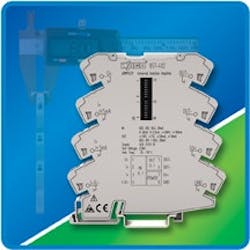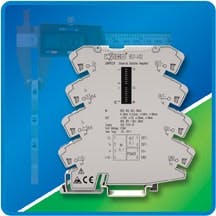Compact USC Packs Exclusives
Whether on a distributor's shelf or in an integrator's control panel, space is precious. However, this is often at odds with the need for higher-voltage signal conversion, amplification and isolation. Industry-wide, universal signal conditioning devices haven't kept pace with the voltage and size demands of downsizing industrial electronics. Those ubiquitous 12.5 mm units handle just up to 100 V.
For more information call 800/346-7245, email [email protected], or browse to www.wago.us/USC.htm
Acknowledging this, Wago developed a new 6 mm wide Universal Signal Conditioner (USC). As part of the company's Jumpflex Series of signal conditioners and relays, the new 857-402 supports 456 different signal combinations. Wago says that via DIP switch, the signals maintain precise, constant values, even after multiple configurations, because of factory-calibrated and laser-capable resistors. In addition, its wide input range of ±0.3 mA to ±100 mA, and ±60 mV to a segment-leading ±200 V supports a broad base of applications while simplifying BOMs, reducing inventory and eliminating order errors."The 857-402's input range extends 100 V beyond existing products available in the market, and is freely scalable," says Michelle Goeman, product manager for electronic interface at Wago. "This supports diverse applications such as monitoring battery voltage of 180 Vdc for railroad applications and automotive test applications—even in operating temperature ranges of -25 to 70 °C."
Further innovations include the use of a Momentary Rocker-style Switch (MRS) instead of a standard screw potentiometer. Unlike traditional pots, the MRS offers enhanced vibration-proof characteristics and does not have an end/stop point. As a result, signal settings/adjustments are more secure and also scalable across the entire measurement range. To maintain signal settings and make them tamper-proof, the MRS also can be disabled via DIP switch.
Advancing safety, Wago added exclusive features such as auto-reset fusing and signal clipping. "The resettable fuse effectively protects the current input against overloads without impacting the input value," Goeman explains. "Once the overload is removed, the fuse automatically resets itself."
The clipping feature safeguards PLCs and other sensitive electronics by switching between limiting and analog behavior. As an example, if a transducer's input exceeds 20 mA, the output signal is clipped at 20 mA. "This preemptive move ensures the PLC's output will continue behaving properly to prevent unnecessary application errors and troubleshooting," Goeman says. "The clipping feature also is shared within our Jumpflex series by the isolation amplifiers, as well as RTD and thermocouple signal conditioners."
Standard features on the new USC include color-coded, push-in jumpers; jumper slots at every connection point; a single marking tag holder; ribbon cable interface adapter; three-way 2.5 kV isolation; and Cage Clamp termination technology.
"The connections are also immune to temperature cycling and aggressive gases for superior signal integrity and reliability, making the USC well-suited to harsh process and machine-building applications," Goeman states. "You don't need to worry about vibration-prone applications loosening screws over time, which causes improper signaling."
According to Goeman, the 6 mm 857-402 USC's features and capabilities make it a design-changer. "Its ability to meet and exceed the industry's needs in a compact unit helps streamline control panels, leading to more compact machinery," she says. "Designers no longer need to devote 12.5 mm to their signal conditioning needs."


